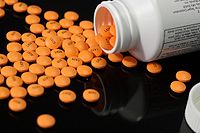
Photo from wikipedia
OBJECTIVE In light of the Cardiovascular Outcomes for People using Anticoagulation Strategies (COMPASS) trial, our objective was to assess the cost-effectiveness, from the Australian healthcare perspective, of rivaroxaban in combination… Click to show full abstract
OBJECTIVE In light of the Cardiovascular Outcomes for People using Anticoagulation Strategies (COMPASS) trial, our objective was to assess the cost-effectiveness, from the Australian healthcare perspective, of rivaroxaban in combination with aspirin versus aspirin alone for the prevention of recurrent cardiovascular disease among patients with stable atherosclerotic vascular disease. METHODS A Markov model was developed using input data from the COMPASS trial to predict the clinical course and costs of patients over a 20-year time-horizon. The model comprised of three health states: 'Alive without recurrent CVD', 'Alive after recurrent CVD' and 'Dead'. Costs were from the Australian public healthcare system perspective, and estimated from published sources, as were utility data. The costs of rivaroxaban were based on current acquisition prices on the Australian Pharmaceutical Benefits Schedule (PBS) and assumed as AUD$3.09/day. The main outcome of interest was the incremental cost-effectiveness ratio (ICER) in terms of cost per quality adjusted life year (QALY) gained, and cost per year of life saved (YoLS). Costs and benefits were discounted by 5.0% per year. RESULTS Compared to aspirin alone, rivaroxaban plus aspirin was estimated to cost an additional AUD$12,156 (discounted) per person, but lead to 0.516 YoLS (discounted) and 0.386 QALYs gained (discounted), over 20 years. These equated to ICERs of AUD$23,560/YoLS and AUD$31,436/QALY gained. We have assumed a threshold of AUD$50,000/QALY gained to signify cost-effectiveness. CONCLUSION Compared to aspirin, rivaroxaban in combination with aspirin is likely to be cost-effective in preventing recurrent cardiovascular events in patients with stable atherosclerotic vascular disease.
Journal Title: International journal of cardiology
Year Published: 2018
Link to full text (if available)
Share on Social Media: Sign Up to like & get
recommendations!